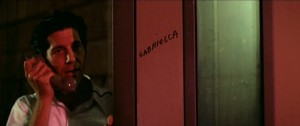A Man in Love (with bonus clip)
 It’s quite a bold move to try to explore mediocrity. Most of us never rise above it anyway. But if you have talent and you use it to look at those who can’t get past the middle, it can be seen as condescending and/or gloating. That’s why the context of mediocrity is so important; when you have the Metallica documentary Some Kind of Monster, which is a 2 ½ hour magnum opus on playing to the middle and not having your heart in your art, the key is that Metallica appears to have no idea how cynical and sad the whole thing is. Sure, you’d think that the co-directors, the savvy filmmakers Joe Berlinger and Bruce Sinofsky, who’ve collaborated on Brother’s Keeper and the three Paradise Lost films, would have the wherewithal to recognize how they presented their subjects, as spoiled crybabies who ought to just retire instead of pumping the soulless nothing that was their St. Anger album. But, no, according to their audio commentary, Sinofsky and Berlinger think they’ve made an incisive “herpes warts and all” film, that shows the band from all sides.
It’s quite a bold move to try to explore mediocrity. Most of us never rise above it anyway. But if you have talent and you use it to look at those who can’t get past the middle, it can be seen as condescending and/or gloating. That’s why the context of mediocrity is so important; when you have the Metallica documentary Some Kind of Monster, which is a 2 ½ hour magnum opus on playing to the middle and not having your heart in your art, the key is that Metallica appears to have no idea how cynical and sad the whole thing is. Sure, you’d think that the co-directors, the savvy filmmakers Joe Berlinger and Bruce Sinofsky, who’ve collaborated on Brother’s Keeper and the three Paradise Lost films, would have the wherewithal to recognize how they presented their subjects, as spoiled crybabies who ought to just retire instead of pumping the soulless nothing that was their St. Anger album. But, no, according to their audio commentary, Sinofsky and Berlinger think they’ve made an incisive “herpes warts and all” film, that shows the band from all sides.
 The more effective way to look at mediocrity is how Francoise Truffaut dealt with it in Day for Night, honest, yet loaded with exuberance within the meta-commentary about making movies. Truffaut plays a version of himself, working on an international co-production with an American star (Jacqueline Bisset, in her best role) and a script rife with compromises. The film they’re making is called Meet Pamela, and from what we see, it’s professionally done, but totally forgettable. The footage is competent, but inert, death for what appears to be a romantic drama. Truffaut shows us how much work goes into such a project and that going through the motions is just as hard, if not more difficult than really believing in what you’re doing.
The more effective way to look at mediocrity is how Francoise Truffaut dealt with it in Day for Night, honest, yet loaded with exuberance within the meta-commentary about making movies. Truffaut plays a version of himself, working on an international co-production with an American star (Jacqueline Bisset, in her best role) and a script rife with compromises. The film they’re making is called Meet Pamela, and from what we see, it’s professionally done, but totally forgettable. The footage is competent, but inert, death for what appears to be a romantic drama. Truffaut shows us how much work goes into such a project and that going through the motions is just as hard, if not more difficult than really believing in what you’re doing.
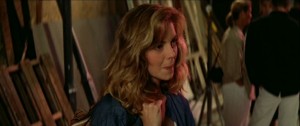 Diane Kurys’ A Man in Love hangs somewhere in between Some Kind of Monster and Day for Night; it’s about an American star (Peter Coyote) traveling to Italy to make a well-meaning but ponderous and clichéd biopic of Italian poet Cesar Pavese. Does Kurys know that this biopic is mediocre? Sometimes, when we see Coyote’s spoiled and self-indulgent movie star behaving like a prima donna instead of doing his job, she seems totally aware of what she’s doing. And then there are other sections of the film, such as the parents of the actress (Greta Sccachi) that Coyote falls in love with, and their troubles with Scacchi’s mother’s cancer that suggest that Kurys forgot which part of her film was supposed to be a parody of limp melodrama. Scacchi’s mother, played by Claudia Cardinale, is appropriately distant and sad without overdoing it, but her husband, played by John Berry is a complete cartoon. First he’s barging onto the set and demanding a magazine interview with Coyote, almost getting his daughter fired before she’s even accepted the supporting part she’s been offered, and then he’s supposed to be the supportive, understanding father doting on his dying wife in other scenes.
Diane Kurys’ A Man in Love hangs somewhere in between Some Kind of Monster and Day for Night; it’s about an American star (Peter Coyote) traveling to Italy to make a well-meaning but ponderous and clichéd biopic of Italian poet Cesar Pavese. Does Kurys know that this biopic is mediocre? Sometimes, when we see Coyote’s spoiled and self-indulgent movie star behaving like a prima donna instead of doing his job, she seems totally aware of what she’s doing. And then there are other sections of the film, such as the parents of the actress (Greta Sccachi) that Coyote falls in love with, and their troubles with Scacchi’s mother’s cancer that suggest that Kurys forgot which part of her film was supposed to be a parody of limp melodrama. Scacchi’s mother, played by Claudia Cardinale, is appropriately distant and sad without overdoing it, but her husband, played by John Berry is a complete cartoon. First he’s barging onto the set and demanding a magazine interview with Coyote, almost getting his daughter fired before she’s even accepted the supporting part she’s been offered, and then he’s supposed to be the supportive, understanding father doting on his dying wife in other scenes.
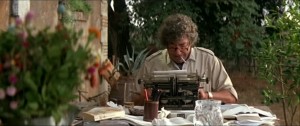 Now part of the problem with Berry’s performance is how out of place he looks. Not just as a character, but physically. He’s supposed to be Greta Scacchi’s father, and the husband of the still gorgeous Cardinale. Scacchi and Cardinale look somewhat alike and match up as a mother and daughter, but Berry looks like Walter Matthau after a sleepless night of boozing and poker. Kurys might have been better off just referring to Berry as Scacchi’s stepfather so we wouldn’t spend most of his scenes trying to do the genetic math in our heads.
Now part of the problem with Berry’s performance is how out of place he looks. Not just as a character, but physically. He’s supposed to be Greta Scacchi’s father, and the husband of the still gorgeous Cardinale. Scacchi and Cardinale look somewhat alike and match up as a mother and daughter, but Berry looks like Walter Matthau after a sleepless night of boozing and poker. Kurys might have been better off just referring to Berry as Scacchi’s stepfather so we wouldn’t spend most of his scenes trying to do the genetic math in our heads.
 And just like with Some Kind of Monster there is little sense of perspective; Coyote’s boorishness may be part of the point, but Scacchi’s character lives with her parents on an enormous French villa, and she enters her relationship with Coyote with complete knowledge that he’s married and has two children, but that he’s never going to leave his wife (Jamie Lee Curtis). Yet she still finds time to get jealous. Scacchi is cheating on her possessive French boyfriend, and it’s unclear what she sees in the spindly Coyote, unless it’s that he’s a 40 year-old-infant who knows how to properly manipulate his wife. These two lovers are hardly secretive and they find themselves rollicking in a rich people’s melodrama with beautiful sets and expansive widescreen photography*. Are we supposed to laugh at Coyote**, a man so vain that in order to maintain his erection while already inside a woman, he needs her to talk dirty to him?
And just like with Some Kind of Monster there is little sense of perspective; Coyote’s boorishness may be part of the point, but Scacchi’s character lives with her parents on an enormous French villa, and she enters her relationship with Coyote with complete knowledge that he’s married and has two children, but that he’s never going to leave his wife (Jamie Lee Curtis). Yet she still finds time to get jealous. Scacchi is cheating on her possessive French boyfriend, and it’s unclear what she sees in the spindly Coyote, unless it’s that he’s a 40 year-old-infant who knows how to properly manipulate his wife. These two lovers are hardly secretive and they find themselves rollicking in a rich people’s melodrama with beautiful sets and expansive widescreen photography*. Are we supposed to laugh at Coyote**, a man so vain that in order to maintain his erection while already inside a woman, he needs her to talk dirty to him?
 The movie’s real hero is played by Peter Riegert, who is Coyote’s gopher/assistant, always there to cover up his messes and appease his constant childish whims. Riegert has a couple of great scenes with Curtis, as he sarcastically (but not really) flirts with her, while using himself as a shield for Coyote’s indiscretions. Curtis knows quite well what’s going on, and her brief appearances are the only time Coyote’s character has to actually deal with something tangible and real. He has a witty moment where Curtis is complaining about their child walking in on the nanny in the bathroom, and how she was naked, and therefore she has to be fired. Coyote responds with, “she was a lousy nanny, she never showed me anything.”
The movie’s real hero is played by Peter Riegert, who is Coyote’s gopher/assistant, always there to cover up his messes and appease his constant childish whims. Riegert has a couple of great scenes with Curtis, as he sarcastically (but not really) flirts with her, while using himself as a shield for Coyote’s indiscretions. Curtis knows quite well what’s going on, and her brief appearances are the only time Coyote’s character has to actually deal with something tangible and real. He has a witty moment where Curtis is complaining about their child walking in on the nanny in the bathroom, and how she was naked, and therefore she has to be fired. Coyote responds with, “she was a lousy nanny, she never showed me anything.”
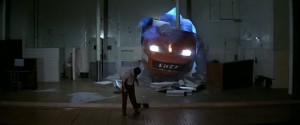 Moments like that is where Kurys forgets she’s making an epic and reveals her gifts when she’s willing to scale back and be intimate. She may have hired George Delerue to write one of his beautiful tragedy scores*** but then she’ll throw in a scene like the one in the video below. This scene has virtually nothing to do with anything (and no, I did not artificially speed up the footage) within the film, it’s just an isolated piece of vaudeville with one or two shots of Scacchi in there to justify itself.
Moments like that is where Kurys forgets she’s making an epic and reveals her gifts when she’s willing to scale back and be intimate. She may have hired George Delerue to write one of his beautiful tragedy scores*** but then she’ll throw in a scene like the one in the video below. This scene has virtually nothing to do with anything (and no, I did not artificially speed up the footage) within the film, it’s just an isolated piece of vaudeville with one or two shots of Scacchi in there to justify itself.
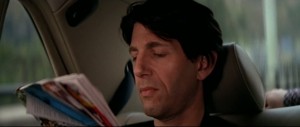 Then there are the sex scenes which are very erotic, surprisingly so since they feature Scacchi and Coyote, two characters who are generally unappealing. But it isn’t as if Coyote suddenly becomes sympathetic; he has a moment that’s a lot funnier now than it would have been in 1987. While reading a trade magazine, he says “oh, De Niro is doing a new film,” which is Coyote’s way of comparing himself to how De Niro used to be thought of, that of a highly respected actor. Now it plays like Coyote’s character is mocking De Niro’s script choices, as in “oh, it’s been a whole week since the last De Niro film, I wonder what Focker sequel is in the pipeline.”
Then there are the sex scenes which are very erotic, surprisingly so since they feature Scacchi and Coyote, two characters who are generally unappealing. But it isn’t as if Coyote suddenly becomes sympathetic; he has a moment that’s a lot funnier now than it would have been in 1987. While reading a trade magazine, he says “oh, De Niro is doing a new film,” which is Coyote’s way of comparing himself to how De Niro used to be thought of, that of a highly respected actor. Now it plays like Coyote’s character is mocking De Niro’s script choices, as in “oh, it’s been a whole week since the last De Niro film, I wonder what Focker sequel is in the pipeline.”
 Kurys may have been able to sell the film on the promise of the nudity and sex scenes (the first of which is shot nearly silently, and without body parts exposed), but it’s obvious she wanted to make a tribute to the movies that inspired her, so we see what looks to be the famous fountain from La Dolce Vita, exteriors being shot at Cinecittà studios, and gobs of visual references to 8 ½, and other famous films about making movies. She isn’t entirely successful at whatever she intended, as A Man in Love tends to be slow and a bit repetitive, but the pacing helps in giving us time to see how the other characters view Coyote. The title may refer to Coyote’s obsession with his own wonders, but it’s clear that in her way, Kurys has really made it about her love for the artificiality of cinema. But mostly her love of mediocrity.
Kurys may have been able to sell the film on the promise of the nudity and sex scenes (the first of which is shot nearly silently, and without body parts exposed), but it’s obvious she wanted to make a tribute to the movies that inspired her, so we see what looks to be the famous fountain from La Dolce Vita, exteriors being shot at Cinecittà studios, and gobs of visual references to 8 ½, and other famous films about making movies. She isn’t entirely successful at whatever she intended, as A Man in Love tends to be slow and a bit repetitive, but the pacing helps in giving us time to see how the other characters view Coyote. The title may refer to Coyote’s obsession with his own wonders, but it’s clear that in her way, Kurys has really made it about her love for the artificiality of cinema. But mostly her love of mediocrity.
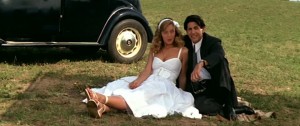 * Apart from its very brief theatrical run in 1987, A Man in Love has only ever been available in a pan and scan format on VHS and laserdisc. Netflix has one of these 1.33 atrocities in its streaming roster. What I used for this review was the French DVD that I got from Daaveedee.com here. The DVD has an anamorphic 2.35 transfer that’s a little soft and doesn’t translate the occasional brief scene in French or Italian (the meanings are not difficult to figure out though). It also runs a few minutes longer than the American cut. It has an interview with Kurys and this French trailer for the film. And besides this disc, your options are… a Russian disc that contains the same cut, but is entirely dubbed into Russian.
* Apart from its very brief theatrical run in 1987, A Man in Love has only ever been available in a pan and scan format on VHS and laserdisc. Netflix has one of these 1.33 atrocities in its streaming roster. What I used for this review was the French DVD that I got from Daaveedee.com here. The DVD has an anamorphic 2.35 transfer that’s a little soft and doesn’t translate the occasional brief scene in French or Italian (the meanings are not difficult to figure out though). It also runs a few minutes longer than the American cut. It has an interview with Kurys and this French trailer for the film. And besides this disc, your options are… a Russian disc that contains the same cut, but is entirely dubbed into Russian.
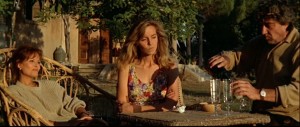 ** Coyote even has to contend with one of those “who do you think you are” scenes, about as original an utterance of the time tested “you don’t get it, do you?”
** Coyote even has to contend with one of those “who do you think you are” scenes, about as original an utterance of the time tested “you don’t get it, do you?”
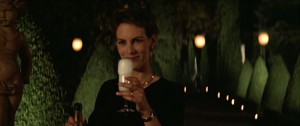 *** Delerue also scored Day for Night and virtually every other memorable European film from Shoot the Piano Player on through to his work with American directors like Oliver Stone, Mike Nichols, John Hughes, Steven Spielberg, etc. He died in 1992 and has an astonishing 351 film composer credits. No, he did not die of exhaustion. Or mediocrity.
*** Delerue also scored Day for Night and virtually every other memorable European film from Shoot the Piano Player on through to his work with American directors like Oliver Stone, Mike Nichols, John Hughes, Steven Spielberg, etc. He died in 1992 and has an astonishing 351 film composer credits. No, he did not die of exhaustion. Or mediocrity.
You can find this rare, widescreen version of A Man in Love at Daaveedee.com



